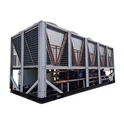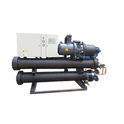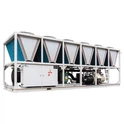What is a chiller?
In the fields of industrial manufacturing and commerce, refrigeration technology is used more and more widely. As an important refrigeration equipment, Chillers play a key role in air conditioning systems, industrial refrigeration and manufacturing processes. Next, we will explain in depth what It's the chiller and how it works, etc.
Chiller Components
The common main components of a chiller include a compressor, condenser, evaporator and control system; in addition, different types of chillers will have other components to achieve special design requirements and use effects.






Chiller Working Principle
The working principle of the chiller is based on the refrigeration cycle.
First, the compressor compresses the refrigerant into a high-pressure and high-temperature gas. Then the high-temperature gas dissipates heat through the condenser, cools it, and converts it into a high-pressure liquid.
Next, the high-pressure liquid enters the evaporator through the expansion valve (throttle device). Through heat exchange with cooling water or chilled water, it absorbs heat and becomes low-pressure evaporated gas. Finally, the low-pressure evaporated gas enters the compressor again, and the cycle repeats.
Heat is absorbed by circulating a fluid, usually a refrigerant, which transfers the heat to a condenser and cools or chills the water through an evaporator.

Chiller Application Areas
Chillers are widely used in many fields. It is a core component in air conditioning systems. It is used to cool and circulate refrigerant to provide comfortable indoor temperatures. From this we can know that in shopping malls, schools, office buildings, supermarkets, factories Water chillers are used in various places.
And chillers play a key role in industrial refrigeration and can be used to cool large equipment and production lines, such as the pharmaceutical industry, chemical industry, food processing and other industries. Chillers are essential refrigeration equipment in the production process.

Chiller Type
The chillers produced by Feizhong can be divided into screw type and scroll type, and these two types can also be divided into air cooling and water cooling. Their application fields are the same, but the difference is that they have different working mechanisms and cooling capacities. , to meet the needs of different users, and also supports user-customized functions and systems.
Features and advantages
Good stability
The chiller has stable cooling effect and precise temperature control, which can continuously provide people with a comfortable and constant-temperature living environment or maintain the necessary temperature requirements for industrial production, thereby improving production efficiency and saving energy. This stability is critical to many industries.
Low energy consumption
The chiller adopts some energy-saving designs to effectively control energy consumption. For example, the air-cooled heat dissipation method is used to save water resources, and advanced compression technology is used to reduce the operating requirements of the machine.
Low noise
The refrigeration part and fan of the chiller use advanced materials and designs, which can greatly reduce the noise generated by the operation of the machine, minimizing the impact on the surrounding environment and personnel when the machine is running.
Easy to maintain
The cleaning and maintenance of the chiller are relatively simple. You only need to clean the radiator and replace the filter element regularly. It does not require much maintenance work. This also reduces machine usage costs.
Easy to install
Compared with other types of refrigeration equipment, chillers are simple to install and easy to operate. This also makes machines widely used in industrial production and people's daily lives.
Maintenance
The chiller needs to work continuously for a long time during use. Maintenance and maintenance are the key to ensuring long-term and efficient operation.
Cleaning: Regular cleaning of the inside and outside of the chiller is the basis for maintaining its normal operation. During the cleaning process, be sure to cut off the power and wait for the chiller to completely stop running, such as the filter, condenser and evaporator, to ensure that they do not accumulate excessive dust and Dirt, use a soft brush and vacuum cleaner to clean, avoid using objects that are too hard to avoid damaging the device.
Cooling water quality: The cooling water quality of the chiller is crucial to its performance and life. Regularly check the pH value, hardness and concentration of chemical additives of the cooling water to ensure that it is within the appropriate range. If necessary, the water quality can be treated or replaced. Cooling water.
Electrical system: Regularly check the electrical system of the chiller, including switches, fuses, terminal blocks, etc., to ensure that the circuit connections are firm and not loose or corroded. If any abnormality is found, it should be repaired or replaced in time.
Lubrication: The power transmission system requires regular lubrication and maintenance, which includes checking the operation of motors, fans, pumps and other components, and adding an appropriate amount of lubricating oil.
Refrigeration circuit: Regularly check the refrigeration circuit of the chiller, including the compressor, condenser, evaporator and refrigerant pipeline, to ensure that the refrigerant cycle is normal and there are no leaks or blockages to ensure normal operation.
Pipe and insulation inspection: Check whether the pipe connections of the chiller are tight, whether there are leaks in the pipes, and whether the insulation materials are damaged to ensure the safety and efficiency of the equipment.
Keep the surrounding environment clean: Make sure the environment around the chiller is clean and free of accumulated debris and dust. Maintain adequate ventilation and air flow to avoid overheating or obstruction of the chiller.











